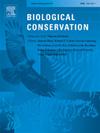Viable conservation of pondscapes includes the ecotones with dryland
IF 4.9
1区 环境科学与生态学
Q1 BIODIVERSITY CONSERVATION
引用次数: 0
Abstract
Marshlands are ecotones between standing water and terrestrial environments, where aquatic and terrestrial species overlap. However, little is known about the assembly rules of organisms inhabiting this ecotone, which is inherently dynamic according to the amount of available water. We separated the waterbody/dryland ecotone of 22 standing waterbodies into five zones according to plant composition, structure, and water depth. Here, the waterbodies had limited inflows and outflows, and were highly responsive to seasonal precipitation events. We then determined the extent to which insect species assemblages change across the five zones and identify environmental factors driving these changes. Each zone had a characteristic suite of plant species, which differed greatly among the standing waterbodies. Dragonflies were present across the entire ecotone, although turnover peaked at the ecotone centre, while butterflies peaked in the grassland zone, along with some marsh-associated species. Grasshoppers preferred grassland associated with the smaller waterbodies. Dragonfly, grasshopper, butterfly, and plant species compositions each responded to their own sets of both aquatic and terrestrial variables. Overall, pond ecotones had high species turnover and high conservation value for both aquatic and terrestrial species, indicating that ponds have a much larger footprint than just the extent of wet areas. The terrestrial buffer zones are required for protection of the local biota. In turn, wet areas provide increased opportunities for dryland species. Buffer zones should be determined not so much in linear metres, but rather should also include dryland, which varies among waterbodies according to micro-topography. Pondscape (all the standing waterbodies) conservation must include all the transition zones, so that the full habitat heterogeneity around such waterbodies is built into the set of functionally connected waterbodies.
求助全文
约1分钟内获得全文
求助全文
来源期刊

Biological Conservation
环境科学-环境科学
CiteScore
10.20
自引率
3.40%
发文量
295
审稿时长
61 days
期刊介绍:
Biological Conservation is an international leading journal in the discipline of conservation biology. The journal publishes articles spanning a diverse range of fields that contribute to the biological, sociological, and economic dimensions of conservation and natural resource management. The primary aim of Biological Conservation is the publication of high-quality papers that advance the science and practice of conservation, or which demonstrate the application of conservation principles for natural resource management and policy. Therefore it will be of interest to a broad international readership.
 求助内容:
求助内容: 应助结果提醒方式:
应助结果提醒方式:


